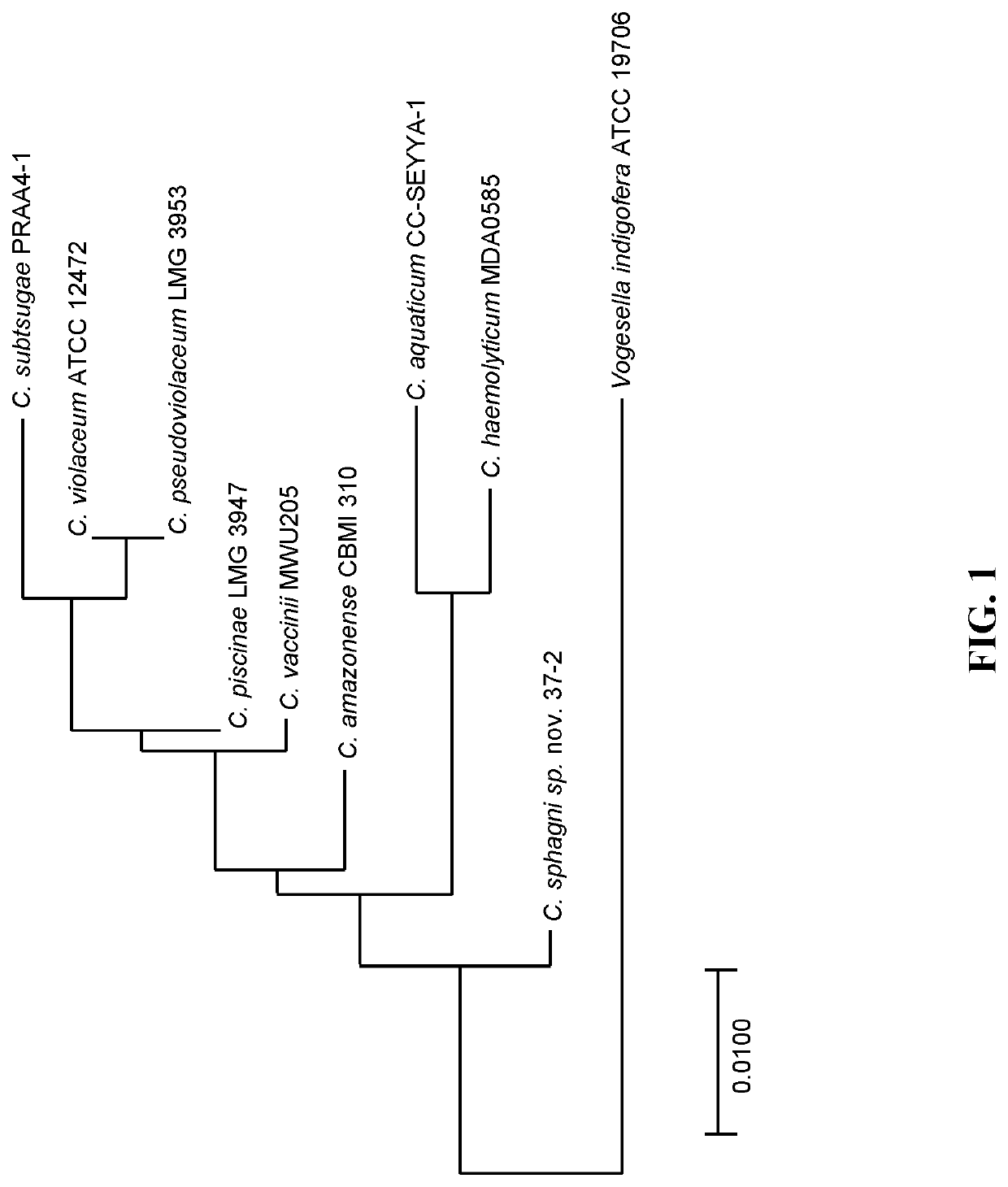Chromobacterium species with insecticidal activity
a chromobacterium and insecticidal technology, applied in the field of new chromobacterium species, can solve the problems of economic pests, predators that cannot reduce the harm caused by larvae to food crops, and cannot reduce economic damage to crops
- Summary
- Abstract
- Description
- Claims
- Application Information
AI Technical Summary
Benefits of technology
Problems solved by technology
Method used
Image
Examples
example 1
of Bacteria
[0034]Two new strains of Chromobacterium sphagni sp. nov. that fulfill the criteria for a new species, strains 14B-4 (NRRL B-67382) and 37-2 (NRRL B-67131), have been obtained. C. sphagni sp. nov. strain 14B-4 (NRRL B-67382) was isolated from a sphagnum bog in the Allegheny Mountains of Randolph County, W. Va. C. sphagni sp. nov. strain 37-2 (NRRL B-67131) was isolated from similar habitat (sphagnum bog) in Androscoggin County, Me. The following thirteen additional isolates of Chromobacterium sphagni sp. nov. with 16S sequences identical to those of SEQ ID NO: 1, SEQ ID NO: 2 and / or SEQ ID NO: 3, were collected from the same sites as C. sphagni sp. nov. strain 14B-4 (NRRL B-67382) and C. sphagni sp. nov. strain 37-2 (NRRL B-67131): 14B-5, 14B-6, 36-1, 36-2, 36-3, 36-4, 36-5, 36-6, 37-1, 37-3, 37-4, 37-5 and 37-6. The distribution of C. sphagni appears restricted to sphagnum bogs, and numbers of C. sphagni recovered from sphagnum bogs suggest that they are not abundant bac...
example 2
nd Biochemical Analyses of Bacteria
[0036]Whole genome sequencing of C. sphagni sp. nov. strain 37-2 (NRRL B-67131) on a PacBio RS II long-read sequencer (Pacific Biosciences, Menlo Park, Calif.) reveal that the strain possesses eight copies of the 16S rRNA gene, like other members of the genus Chromobacterium, and that nucleotide 1452 could be either T (SEQ ID NO: 1; 5 gene copies) or C (SEQ ID NO: 2; 3 gene copies). Conventional DNA sequencing of PCR amplified fragments of 16S rRNA genes from C. sphagni sp. nov. strain 14B-4 (NRRL B-67382) yield the sequence of SEQ ID NO: 3, which spans nucleotides 60 to 1491 of SEQ ID NO: 1 and SEQ ID NO: 2. SEQ ID NO: 3 shows that C. sphagni sp. nov. strain 14B-4 (NRRL B-67382) has a sequence identical to nucleotides 60 to 1491 of SEQ ID NOs: 1 and 2, obtained from C. sphagni sp. nov. strain 37-2 (NRRL B-67131), except that nucleotide 456 for 16S rRNA genes in SEQ ID NOs: 1 and 2 are C, and the corresponding nucleotide (located at the same positi...
example 3
dal Activity
[0042]C. subtsugae PRAA4-1T displays broad insecticidal activity when assayed against the lepidopteran diamondback moth or gypsy moth, and the dipteran seedcorn maggot. Meanwhile, C. vaccinii MWU205T appears active only against the seedcorn maggot (which differs from the activity of C. vaccinii MWU205T presented in WO 2015 / 020848 (Martin and Soby)). In contrast, C. sphagni sp. nov. strains 14B-4 and 37-2 display insecticidal activity comparable to C. subtsugae PRAA4-1T against diamondback moth (see Tables 2 and 3, infra) and gypsy moth (see Table 4 for strain 14B-4 only, infra), but not against seedcorn maggot (data not presented). C. sphagni sp. nov. 37-2 also substantially inhibits growth of the lepidopteran pests tobacco hornworn and cabbage looper (see Tables 5 and 6, infra).
[0043]For diamondback moth, gypsy moth and seedcorn maggot, freeze dried pellets of insect diet are rehydrated with whole liquid cultures of Chromobacterium species (C. sphagni sp. nov. strain 14...
PUM
 Login to View More
Login to View More Abstract
Description
Claims
Application Information
 Login to View More
Login to View More - R&D
- Intellectual Property
- Life Sciences
- Materials
- Tech Scout
- Unparalleled Data Quality
- Higher Quality Content
- 60% Fewer Hallucinations
Browse by: Latest US Patents, China's latest patents, Technical Efficacy Thesaurus, Application Domain, Technology Topic, Popular Technical Reports.
© 2025 PatSnap. All rights reserved.Legal|Privacy policy|Modern Slavery Act Transparency Statement|Sitemap|About US| Contact US: help@patsnap.com

